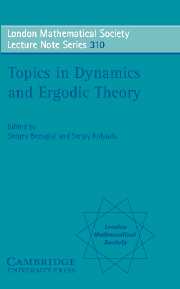Book contents
- Frontmatter
- Contents
- Preface
- Alexeyev's photo
- Introductory talk at the opening of the conference
- Minimal idempotents and ergodic Ramsey theory
- Symbolic dynamics and topological models in dimensions 1 and 2
- Markov odometers
- Geometric proofs of Mather's connecting and accelerating theorems
- Structural stability in one dimensional dynamics
- Periodic points of nonexpansive maps: a survey
- Arithmetic dynamics
- The defect of factor maps and finite equivalence of dynamical systems
- Actions of amenable groups
Structural stability in one dimensional dynamics
Published online by Cambridge University Press: 18 August 2009
- Frontmatter
- Contents
- Preface
- Alexeyev's photo
- Introductory talk at the opening of the conference
- Minimal idempotents and ergodic Ramsey theory
- Symbolic dynamics and topological models in dimensions 1 and 2
- Markov odometers
- Geometric proofs of Mather's connecting and accelerating theorems
- Structural stability in one dimensional dynamics
- Periodic points of nonexpansive maps: a survey
- Arithmetic dynamics
- The defect of factor maps and finite equivalence of dynamical systems
- Actions of amenable groups
Summary
Abstract. This is a set of notes of a series of lectures given by the author on the International conference on Dynamical Systems and Ergodic Theory, Katseveli 2000 where we will demonstrate a various techniques and methods used in the study of interval maps. In particular, we will focus on the negative Schwarzian derivative condition and on the density of Axiom A maps.
INTRODUCTION
The aim of this paper is to introduce the Structural stability problem and to demonstrate different techniques and methods of the theory of Dynamical systems on examples arising from this problem. Though these methods usually are quite technical, we will try to avoid giving all the details and instead we will try to demonstrate the underlying ideas.
The Structural stability problem deals with the following question: What dynamical systems do not change their topological behaviour under small perturbations? Such dynamical systems are called structurally stable:
Definition 1. Let M be a manifold. The Ckmap f : M → M is called Ck structurally stable if there is ∊ > 0 such that any Ckmap g : M → M, ||f — g||Ck < ∊, is topologically conjugate to f (i.e. there exists a homeomorphism h of M such that g º h = h º f).
Information
- Type
- Chapter
- Information
- Topics in Dynamics and Ergodic Theory , pp. 107 - 124Publisher: Cambridge University PressPrint publication year: 2003
Accessibility standard: Unknown
Why this information is here
This section outlines the accessibility features of this content - including support for screen readers, full keyboard navigation and high-contrast display options. This may not be relevant for you.Accessibility Information
- 1
- Cited by
